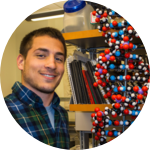About This Project
Bacteria have evolved many genes to make them resistant to most of our antibiotics. Such genes can be moved between bacteria by gene traffickers called plasmids. Even more troubling is that plasmids can move antibiotic resistance genes from one bacterial community to another, such as from the soil in your backyard to your barefoot skin. Here's where I come in! To what extent are antibiotic resistance genes spread between us and the environment?Ask the Scientists
Join The DiscussionWhat is the context of this research?
Although one of the most significant medical
advancements of the 20th century, the widespread use of antibiotics in clinical and agricultural settings has resulted in the contamination of downstream environmental systems and the selection for bacterial cells containing antibiotic resistance genes (ARGs).
ARGs are often carried by mobile genetic elements called plasmids that move freely between bacterial species, conferring resistance in bacterial cells previously susceptible to antibiotics.
Anthropogenically-influenced environments and the human gut microbiome act as reservoirs for ARGs, and such ARGs may be exchanged between environmental and human bacterial communities.
However, the mechanisms and extent of which environment-human ARG transfer occurs is not well characterized.
What is the significance of this project?
In this arms race between modern antibiotics and resistance-evolving bacteria, understanding the ways ARGs are spread between different microenvironments, and identifying the prominent ARGs and plasmids that traffic them is essential to the preservation of our antibiotics' efficacy.
However, due to the threat of antibiotic resistance on human health, most of the research in this field has concentrated on resistance in clinical environments, and only recently have there been extensive efforts to analyze ARGs in the environment.
In investigating the plasmid-borne ARGs moving between Wheaton College and the environment, this study will contribute to the growing literature detailing the environmental reservoir for ARGs and the nature of their dissemination to and from human and non-human niches.
What are the goals of the project?
Sampling
- Wheaton College student fecal matter
- The college's waste water treatment plant (WWTP) effluent
- Water from the Rumford River, which receives the WWTP effluent
- Water from the Pine Street gravel-packed well, which processes water from the Rumford River and supplies Wheaton College with its drinking water
Outcomes
Plasmid DNA isolated from the above samples will be sequenced and analyzed to determine the extent of ARG movement between Wheaton College student and neighboring environmental microbiomes.
If identical plasmid-residing ARGs are found in
any subset of the samples collected, the findings will corroborate the literature that ARGs have the potential to be exchanged between different microbial communities, including those associated with humans and natural environments.
Budget
Although most of the equipment needed to collect the samples and isolate the plasmid-DNA is available to me through the Wheaton College Biology Department, the cost of sequencing the isolated plasmid-DNA is not covered. Next-generation sequencing (NGS) technology is both the key component and limiting factor of this project. The plasmid-DNA sequences I hope to obtain through NGS will be the data goldmine I sift through to identify antibiotic resistance genes. Without covering the cost of NGS, no sequence data will be generated and this project will unfortunately not leave the ground.
Meet the Team
Team Bio
I began my undergraduate research career studying fruit fly genetics on a variety of topics such as memory, aggression, and Parkinson's Disease. Despite my love for fruit flies, the topic of antibiotic resistance recently caught my attention after watching a documentary on multi-drug resistant "superbugs". I quickly became both fascinated with and spooked by the capability of antibiotic resistance genes (ARGs) to move between human and environmental bacterial communities. Along with my passion for the underlying biology, understanding antibiotic resistance as a serious global public health threat motivates me to contribute the work of my Honors Thesis to the tracking of ARGs in the environment.Outside of the laboratory, I am a guitarist in jazz & funk bands. I have also written many pieces for solo guitar and jazz ensembles, and composed a string quartet. Upon graduating from Wheaton College this spring, I plan to apply to medical school and begin my journey towards becoming a doctor.
Additional Information
The banner image at the top of the page is of E. Coli, a bacterial species normally residing in the digestive tracts of humans believed to be increasingly resistant to certain antibiotics (image taken from https://www.ctsacentral.org/carousel/33).References.
1. Craig, Nancy L. (2012).Transposition. (2012). Harvard Medical School, 1–42.
2. Fondi, M., & Fani, R. (2010). The horizontal flow of the plasmid resistome: clues from inter-generic similarity networks. Environmental Microbiology, 12(12), 3228–3242.doi:10.1111/j.1462-2920.2010.02295.x
3. Gillings, M. R. (2013). Evolutionary consequences of antibiotic use for the resistome, mobilome, and microbial pangenome, 1–10. doi:10.3389/fmicb.2013.00004/abstract
4. Palmer, K. L., Kos, V. N., & Gilmore, M. S. (2010). Horizontal gene transfer and the genomics of enterococcal antibiotic resistance. Current Opinion in Microbiology, 13(5), 632–639. doi:10.1016/j.mib.2010.08.004
5. Szczepanowski, R., Linke, B., Krahn, I., Gartemann, K.-H., Gützkow, T., Eichler, W., et al. (2009). Detection of 140 clinically relevant antibiotic-resistance genes in the plasmid metagenome of wastewater treatment plant bacteria showing reduced susceptibility to selected antibiotics. Microbiology (Reading, England), 155(Pt 7), 2306–2319. doi:10.1099/mic.0.028233-0
6. Wibberg, D., Szczepanowski, R., Eikmeyer, F., Pühler, A., & Schlüter, A. (2013). The IncF plasmid pRSB225 isolated from a municipal wastewater treatment plant's on-site preflooder combining antibiotic resistance and putative virulence functions is highly related to virulence plasmids identified in pathogenic E. coli isolates. Plasmid, 69(2), 127–137. doi:10.1016/j.plasmid.2012.11.001
7. Wright, G. D. (2013). The antibiotic resistance “mobilome”: searching for the link between environment and clinic, 1–7. doi:10.3389/fmicb.2013.00138/abstract
Project Backers
- 24Backers
- 100%Funded
- $3,000Total Donations
- $125.00Average Donation
